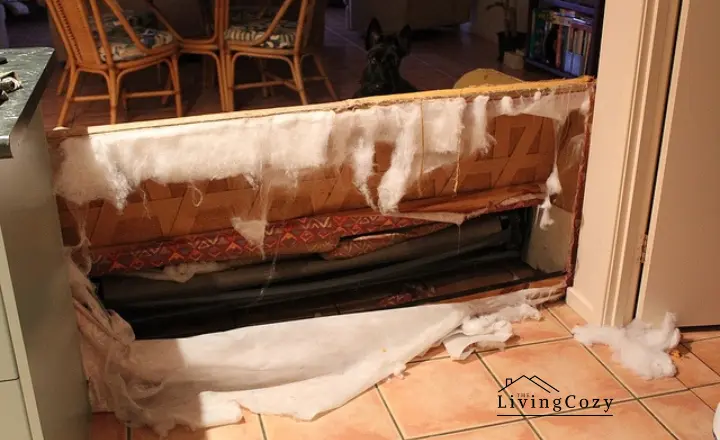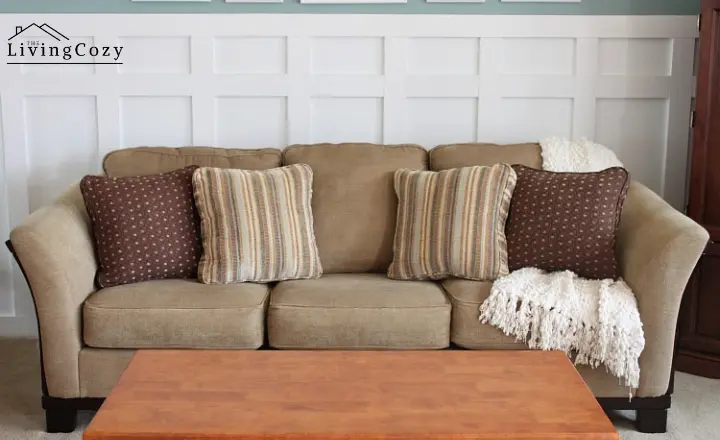You might quickly assume that a sagging couch cushion indicates the need for a new couch, but several easy solutions exist to rectify the issue and make your seating feel as good as new.
This article will guide you through how to fix a sagging couch and provide some extra tips for repairing and maintaining your couch.
What’s Causing Your Couch to Sag?
These are common factors, but they’re not always the culprit behind that unsightly sinkhole developing in your favorite couch.
Sofa Cushions Need to be Refilled:
The most common issue causing sagging is that your sofa cushions become less resilient and start losing their signature ‘plumpness.’
Everyday use causes wear on those cushion inserts, leading them to deflate from their once glorious, fully-filled status. The foam inside gets less springy. Feathers lose their fluffiness, or synthetic fibers compact together.
Your Frame is in Bad Shape:
A fundamental cause of your sagging sofa could be that its Frame is in Bad Shape. The frame is the lifeblood of any piece of furniture, especially our beloved sofas.
No matter how top-notch your cushions are, sagging becomes inevitable if the framework supporting them warps or breaks down due to wear and tear or poor maintenance.
Broken Support Springs:
Over time, due to vigorous usage, the hidden heroes that keep your sofa plump, sturdy, and shape-retaining can become fatigued and snap under pressure. Often unseen by us, their gradual decline may lead to unsightly sagging.
How to fix a sagging couch with plywood?

Understanding how to fix a sagging couch with plywood certainly adds an exciting twist to home DIY projects that go beyond aesthetics.
There are two issues plywood can resolve regarding a sagging couch. These are broken slats or broken frames. Now, We are going to explain how to fix both.
Tools you need for the job:
Replacement wood, Screwdriver, Wood filler, Nail remover, Staple gun
- You need to check whether any slats or frames are broken. If they are damaged, carefully remove them. Pry out any nails or broken springs attached to the wood.
- Note these dimensions as an accurate measure of the replacement wood is needed for a proper fit, and add some extra measurements in case you forget.
- Remove the broken boards with the new ones using your staple gun to secure them. Add wood glue to the joints for extra security, and let everything dry overnight.
- Once your wood glue is set, reupholster your sofa by replacing any fabric or springs.
Repairing Your Couch’s Support:
When it comes to maintaining your beloved couch’s longevity, its structural foundation’s importance cannot be overstated.
It is where supporting elements like wooden frames, metal frames, and spring supports come into play.
Wood frames:
Wood frames integrate excellent framework stability and longevity. Yet, as reliable as they may be, wood frames falter over time due to continued use or heavy pressure. To repair your couch support, take the measurements of the Frame.
Procuring accurate dimensions of the troubled areas can offer a sense of accomplishment. You will gain clarity about the gravity of the damage dealt. This step helps identify whether you need a patch-up job or complete frame replacement, considerably reducing further damage while increasing lifespan.
Metal frames:
Metal frames, these undergirdings play a significant role in retaining the couch’s structure and comfort level. Metal frames bring durability to the table. A little understanding of their functioning can go a long way toward managing minor problems yourself.
You’d be surprised at how something as simple as tightening loose screws or straightening bent components of the Frame could make all the difference to your sagging sofa.
Metal Springs:
The vast majority of comfort-related issues with your couch are Metal Springs. These are the primary supports in most couch structures, profoundly influencing their firmness and overall comfort. Check if any springs are broken or bent. If bent, it can be fixed by a pair of pliers.
Replacing and Refilling Your Sofa’s Cushions:

For properly attached cushions, unzip each one carefully and explore its interior. Understand whether it needs a soft touch-up or a significant overhaul.
For minor sagging problems, replacing and refilling sofa cushions becomes effective. By investing in quality replacement foam for your cushions, you immediately elevate the comfort offered by your furniture while potentially improving its lifespan.
Opting for a high-density foam will ensure it retains its bounce and form over an extended period.
Extra Tips for Repairing and Maintaining Your Couch:

Here are some extra tips for repairing and maintaining your couch:
- Regular Vacuuming: One of the simplest and most effective ways to maintain your couch is by vacuuming it regularly. It helps remove dust, dirt, and allergens that can accumulate over time and cause damage to your couch’s fabric. Use a brush attachment to clean the surface and crevices gently.
- Stain Removal: If you notice any stains on your couch, act quickly, as fresh colours are more accessible to remove. Use a clean cloth and mild detergent or specific upholstery cleaner. Always blot the stain instead of rubbing it, as rubbing can spread it further into the fabric.
- Professional Cleaning: Consider professionally cleaning it once every 12-24 months, depending on your couch’s use. This deep cleaning process can help remove stubborn stains and dirt, leaving your couch looking like new again. A fabric protector spray can also help keep your sofa looking fresh in between professional cleanings.
Remember that different types of upholstery require other care methods, so always check the manufacturer’s instructions before applying any cleaning products to avoid damaging your furniture.
Conclusion:
Fixing a sagging couch can be simple and cost-effective if you put in the time and effort. You can breathe new life into your old furniture by properly assessing the issue, gathering the necessary materials, and following the steps in how to fix a sagging couch.
Not only will this save money on costly replacements, but it will also contribute to a more sustainable lifestyle by reducing waste. So don’t discard your sagging couch just yet. Gather your tools and get ready to restore its former glory.
Remember, a little DIY project might be all between you and a comfortable evening at home.
FAQ’s:
How can I make my Sofa Firmer?
The most common method is replacing or adding more stuffing to your cushions. Over time, cushion fillings tend to compress and lose their firmness. You can purchase new foam or batting from a fabric store, cut it to size, replace the old stuffing, or add more to what’s already there.
How do you fix a Sagging Couch with Plywood?
1. You need to check whether any slats or frames are broken. If they are damaged, carefully remove them. Also, pry out any nails or broken springs attached to the wood.
2. Note these dimensions as an accurate measure of the replacement wood is needed for a proper fit, and add some extra measurements in case you forget.
3. Remove the broken boards with the new ones using your staple gun to secure them. Add wood glue to the joints for extra security, and let everything dry overnight.
4. Reupholster your sofa by replacing any fabric or springs once your wood glue is set.


